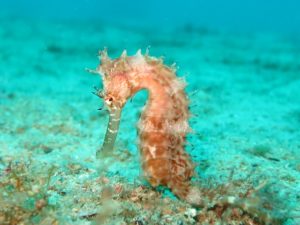Welcome to this article about seahorses! The seahorse is a fascinating species of marine fish that are quite different from your average fish. Their neck and head regions tend to imitate that of a horse, hence their name. Join us as we explore a few facts regarding this interesting creature.

Scientific and Physical Characteristics
- The seahorse belongs to the genus Hippocampus and consists of around 45 species of marine fish. Hippo and campus can be loosely translated from Ancient Greek to ‘horse’ and ‘sea animal’.
- Seahorses have a wide range of sizes, from around 1 inch to over 1 foot long.
- They are most noted for their appearance that is similar to that of a horse. They have a bent neck with a long snout. Their posture is usually upright and their tail is prehensile, enabling the seahorse to use it as a limb for grabbing onto plants or any other object.
- They are typically slow and lethargic swimmers so they tend to rest in one place for long periods which is why they have a prehensile tail.
- The skin of a seahorse comes across as quite bony. This is because the epidermis is stretched across bony plates, giving it a hard exterior. This will serve as extra protection against predators.
- Seahorses swim upright as opposed to horizontally by propelling themselves using a dorsal fin. Pectoral fins located on the side of their head enables the seahorse to swim in a particular direction and maneuver itself.
- Seahorses are also known for their camouflage abilities, often growing appendages that mimic the color of their surroundings.
- The eyes of a seahorse can move independently of the other which is another adaptation to hiding from predators and searching for food.
Habitat and Distribution
- Seahorses mostly live in enclosed areas such as coral reefs, seagrass beds, mangroves, and estuaries.
- They are territorial species. Males usually have a habitat range of around 1 m2 while females can have a range of around 100m2.
- The populations of seahorses are distributed across shallow waters of the tropical and temperate saltwater. They avoid deep waters due to the lack of their ability to swim efficiently.
- Species of seahorse have also been discovered in from North America to South America as well as in the Thames Estuary of Europe.
Diet
- Their primary diet consists of small crustaceans such as mysid shrimp, although seahorses have been observed to eat other small invertebrates and larval fish as well.
- Due to their camouflage and minimal movement, they tend to ambush their prey when it is within range of striking. The thin, streamlined head of the seahorse enables it to spring its head forward during the ambush.
- Once the prey is within range and prior to striking, the seahorse gives an upward thrust which causes the head to rotate instantly using sharp elastic energy. This will bring its snout close to the prey.
- The seahorse will suck the prey within close range. This entire process is known as ‘pivot feeding’.
- If the environment it is in is not abundant with vegetation, it will usually sit still until prey comes within range. However, if the area is filled with plants, the seahorse normally travels around to inspect the environment for prey.
Behavior
- Seahorses have been observed to swim in pairs of two, typically with their tails linked together as well. They have been noted for being a monogamous species and they tend to bond for life.
- They are not vulnerable to other predators due to their bony exterior.
- One of the most popular facts about seahorses is that they are among the only species in the world with the ability for the male animal to give birth to offspring.
- Prior to mating, seahorses have a complex courting process where they engage in a ‘dance’ that can last for hours to days. They can swim side by side, rotate in unison and even change colors. This is believed to synchronize the cycle so that the male can receive the eggs while the female produces them.
- During mating, the female seahorse will deposit around 50-1000 eggs (Depending on the species) into a ‘pouch’ attached to the male’s body. The male will self-fertilize the eggs after this.
- The pouch provides all the necessary requirements for the eggs to develop. After 2-4 weeks, the eggs will start to hatch and the baby ‘fry’ will be released via contractions.
- The fry will survive on their own but only a handful will grow into adults due to predators.
- Seahorses are under threat due to overfishing, climate change, and habitat loss. They are commonly used in the Chinese Traditional Medicine trade that harvests around 150 million seahorses per year.
- Seahorses are also taken for the pet trade but they function poorly outside their natural habitat due to the lack of a proper diet.
I hope that these facts about seahorses were helpful. If you want to see facts about other animals, visit animal facts page!
